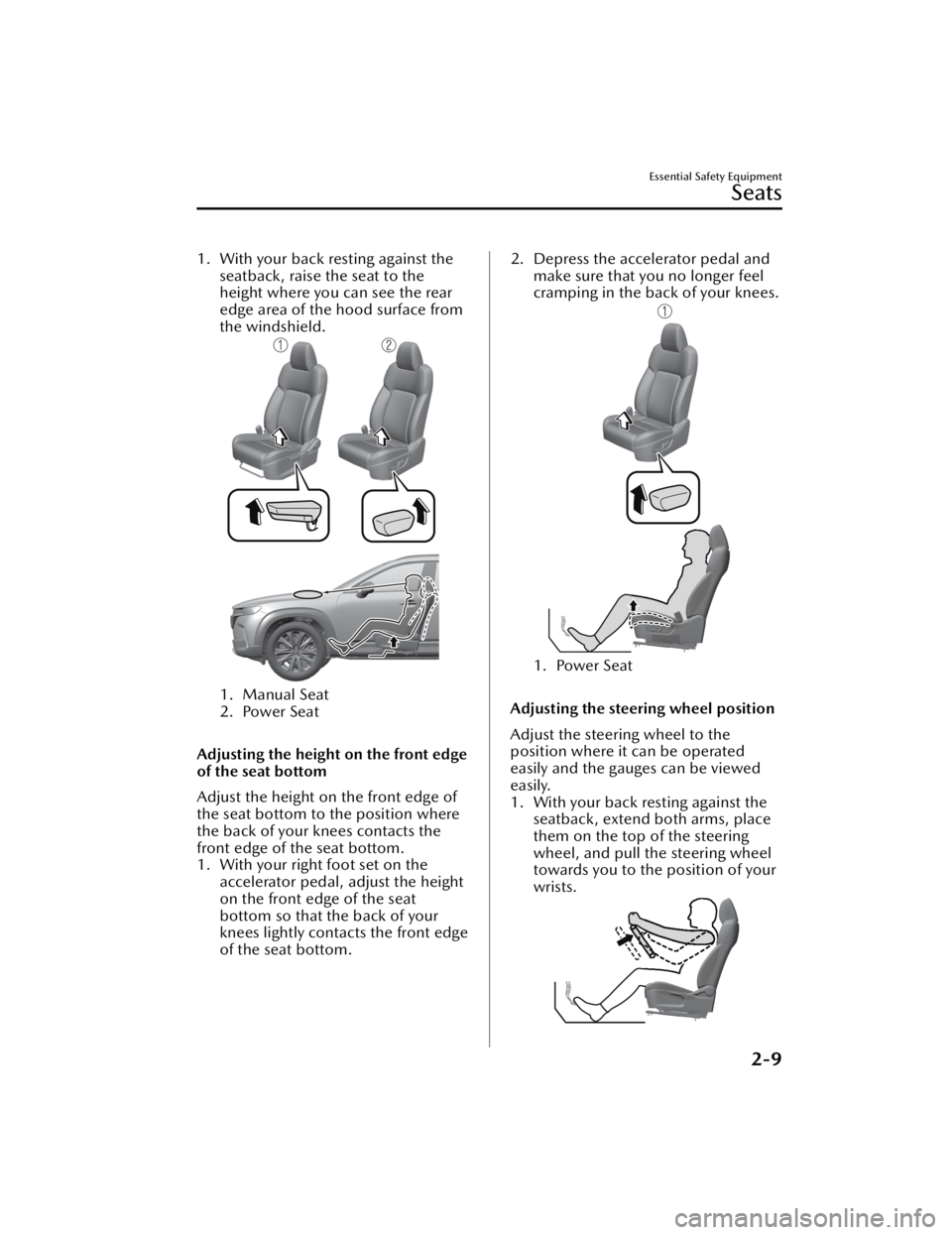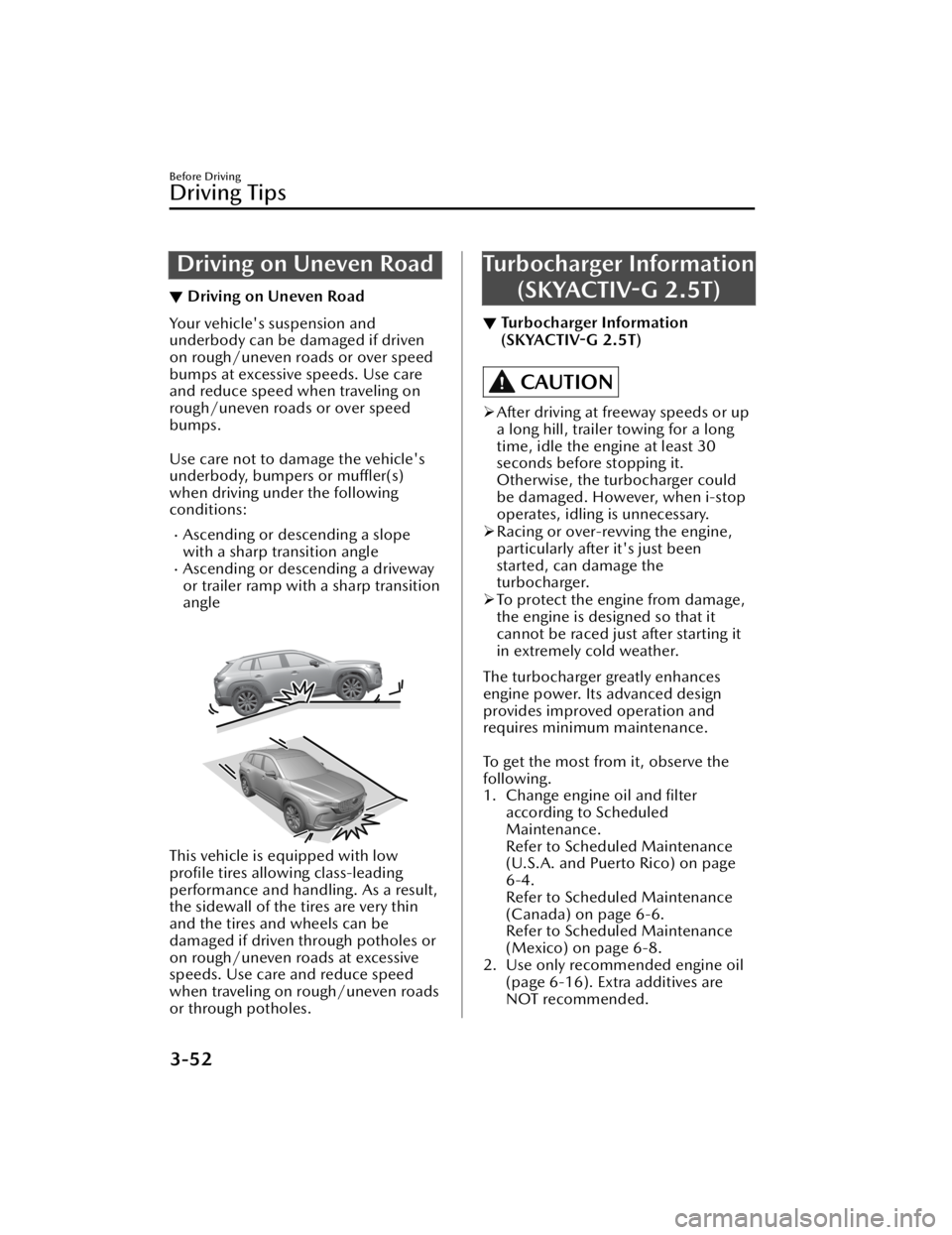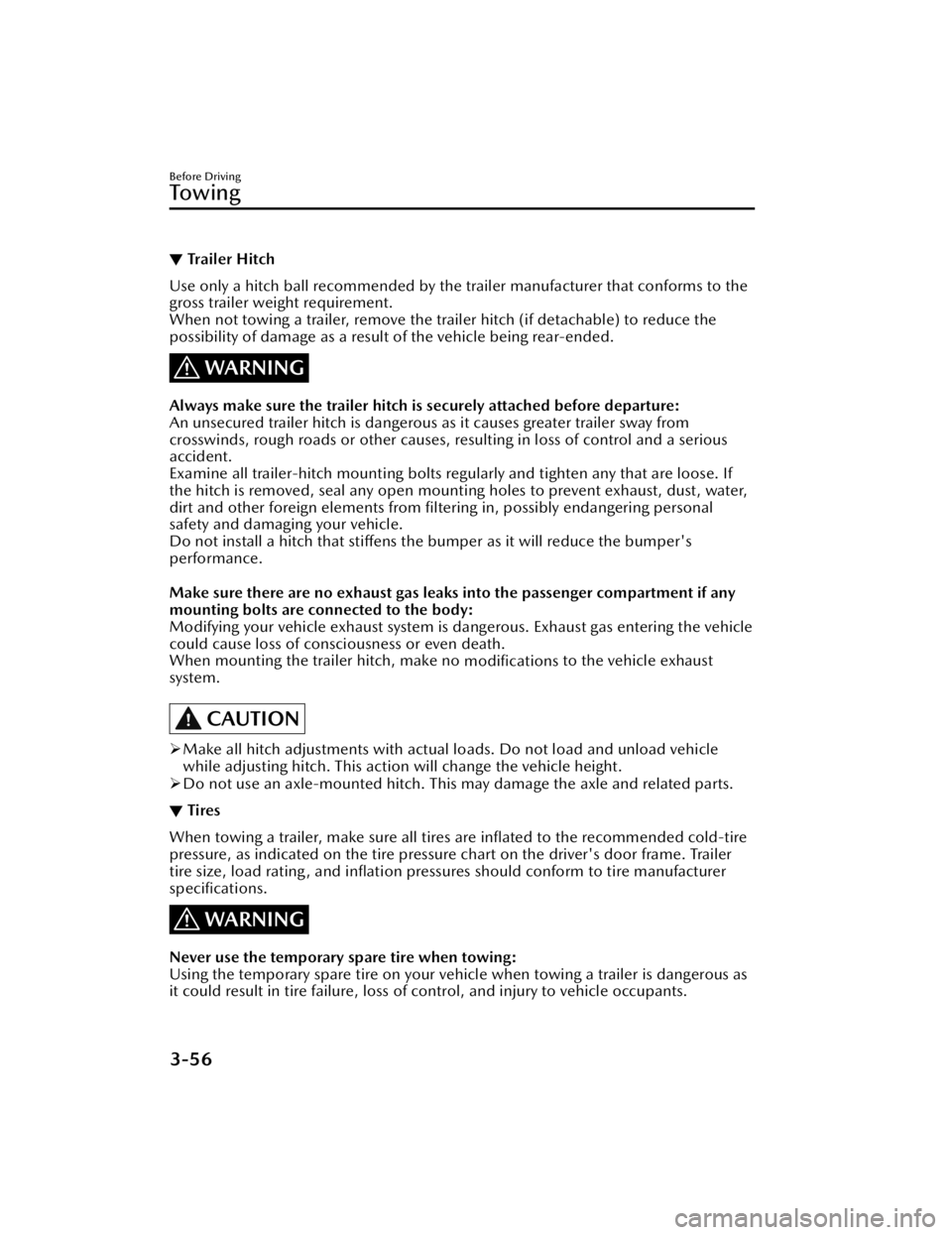tow MAZDA MODEL CX-50 2023 Owners Manual
[x] Cancel search | Manufacturer: MAZDA, Model Year: 2023, Model line: MODEL CX-50, Model: MAZDA MODEL CX-50 2023Pages: 583, PDF Size: 85.63 MB
Page 26 of 583

1. With your back resting against theseatback, raise the seat to the
height where you can see the rear
edge area of the hood surface from
the windshield.
1. Manual Seat
2. Power Seat
Adjusting the height on the front edge
of the seat bottom
Adjust the height on the front edge of
the seat bottom to the position where
the back of your knees contacts the
front edge of the seat bottom.
1. With your right foot set on the accelerator pedal, adjust the height
on the front edge of the seat
bottom so that the back of your
knees lightly contacts the front edge
of the seat bottom.
2. Depress the accelerator pedal andmake sure that you no longer feel
cramping in the back of your knees.
1. Power Seat
Adjusting the steering wheel position
Adjust the steering wheel to the
position where it can be operated
easily and the gauges can be viewed
easily.
1. With your back resting against the seatback, extend both arms, place
them on the top of the steering
wheel, and pull the steering wheel
towards you to the position of your
wrists.
Essential Safety Equipment
Seats
2-9
CX-50_8KB8-EA-22A_Edition2_new 2022-1-6 14:55:18
Page 48 of 583

Child-RestraintPrecautions
▼ Child-Restraint Precautions
Mazda strongly urges the use of
child-restraint systems for children
small enough to use them.
You are required by law to use a
child-restraint system for children in
the U.S. and Canada.
Check your local and state or
provincial laws for specific
requirements regarding the safety of
children riding in your vehicle.
Whatever child-restraint system you
consider, please pick the appropriate
one for the age and size of the child,
obey the law and follow the
instructions that come with the
individual child-restraint system.
A child who has outgrown
child-restraint systems should sit in the
rear and use seat belts, both lap and
shoulder. If the shoulder belt crosses
the neck or face, move the child closer
to the center of the vehicle in the
outboard seats, and towards the
buckle on the right if the child is seated
on the center seat.
Statistics confirm that the rear seat is
the best place for all children up to 12
years of age, and more so with a
supplemental restraint system (air
bags).
A rear-facing child-restraint system
should
NEVER be used on the front
seat with the air bag system activated.
The front passenger's seat is also the
least preferred seat for other
child-restraint systems.
(With Driver and Front Passenger
Occupant Classification System)
To reduce the chance of injuries
caused by deployment of the front
passenger air bag , the front passenger
seat weight sensors occupant
classification sensor works as a part of
the supplemental restraint system. This
system deactivates the front passenger
front and side air bags and knee air
bags, and also the front passenger seat
belt pretensioner system when the
front passenger air bag deactivation
indicator light illuminates.
When an infant or small child sits on
the front passenger seat, the system
shuts off the front passenger front and
side air bags and knee air bags, and
seat belt pretensioner system, so make
sure the front passenger air bag
deactivation indicator light illuminates.
Even if the front passenger air bag is
shut off, Mazda strongly recommends
that children be properly restrained
and child-restraint systems of all kinds
are properly secured on the rear seats
which are the best place for children.
For more details, refer to "Front
passenger seat weight sensors" (page
2-67).
Essential Safety Equipment
Child Restraint
2-31
CX-50_8KB8-EA-22A_Edition2_new 2022-1-6 14:55:18
Page 90 of 583

3Before Driving
Use of various features, including keys, doors, mirrors and
windows.
Keys........................................ 3-2 Keys...................................... 3-2
Keyless Entry System...............3-4
Advanced Keyless Entry
System.....................................3-9 Advanced Keyless Entry
System
*................................. 3-9
Operational Range...............3-10
Doors and Locks..................... 3-11 Door Locks.......................... 3-11
Liftgate................................ 3-19
Fuel and Emission................... 3-27 Fuel and Engine Exhaust
Precautions......................... 3-27
Fuel-Filler Lid and Cap..........3-29
Mirrors.................................. 3-32 Mirrors................................3-32
Windows............................... 3-36 Power Windows...................3-36
Pa n o ra m a S u n ro o f
*.............. 3-39
Security System.......................3-42Modification and Add-
On Equipment..................... 3-42
Immobilizer System..............3-42
Theft-Deterrent System
*........3-44
Driving Tips............................ 3-46 Break-In Period.................... 3-46
Saving Fuel and Protection of the
Environment........................ 3-46
Hazardous Driving............... 3-47
Floor Mat............................ 3-48
Rocking the Vehicle..............3-49
Winter Driving..................... 3-49
Driving In Flooded Area........3-51
Overloading........................ 3-51
Driving on Uneven Road.......3-52
Turbocharger Information
(SKYACTIV-G 2.5T).............. 3-52
Towing.................................. 3-53 Trailer Towing (U.S.A. and
Canada)..............................3-53
Recreational Towing............. 3-61
*Some models.3-1
CX-50_8KB8-EA-22A_Edition2_new 2022-1-6 14:55:18
Page 135 of 583

Break-In Period
▼Break-In Period
No special break-in is necessary, but a
few precautions in the
first 1,000 km
(600 miles) may add to the
performance, economy, and life of the
vehicle.
Do not race the engine.Do not maintain one constant
speed, either slow or fast, for a long
period of time.
Do not drive constantly at
full-throttle or high engine rpm for
extended periods of time.
Avoid unnecessary hard stops.Avoid full-throttle starts.Do not tow a trailer.
Saving Fuel and
Protection of the Environment
▼ Saving Fuel and Protection of the
Environment
How you operate your Mazda
determines how far it will travel on a
tank of fuel. Use these suggestions to
help save fuel and reduce CO
2.
Avoid long warm-ups. Once the
engine runs smoothly, begin driving.
Avoid fast starts.Drive at lower speeds.Anticipate when to apply the brakes
(avoid sudden braking).
Follow the maintenance schedule
and have an Authorized Mazda
Dealer perform inspections and
servicing.
Refer to Scheduled Maintenance
(U.S.A. and Puerto Rico) on page
6-4.
Refer to Scheduled Maintenance
(Canada) on page 6-6.
Refer to Scheduled Maintenance
(Mexico) on page 6-8.
Use the air conditioner only when
necessary.
Slow down on rough roads.Keep the tires properly inflated.Do not carry unnecessary weight.Do not rest your foot on the brake
pedal while driving.
Keep the wheels in correct
alignment.
Keep windows closed at high
speeds.
Slow down when driving in
crosswinds and headwinds.
Before Driving
Driving Tips
3-46
CX-50_8KB8-EA-22A_Edition2_new
2022-1-6 14:55:18
Page 141 of 583

Driving on Uneven Road
▼Driving on Uneven Road
Your vehicle's suspension and
underbody can be damaged if driven
on rough/uneven roads or over speed
bumps at excessive speeds. Use care
and reduce speed when traveling on
rough/uneven roads or over speed
bumps.
Use care not to damage the vehicle's
underbody, bumpers or
muffler(s)
when driving under the following
conditions:
Ascending or descending a slope
with a sharp transition angle
Ascending or descending a driveway
or trailer ramp with a sharp transition
angle
This vehicle is equipped with low
profile tires allowing class-leading
performance and handling. As a result,
the sidewall of the tires are very thin
and the tires and wheels can be
damaged if driven through potholes or
on rough/uneven roads at excessive
speeds. Use care and reduce speed
when traveling on rough/uneven roads
or through potholes.
Turbocharger Information (SKYACTIV-G 2.5T)
▼Turbocharger Information
(SKYACTIV-G
2.5T)
CAUTION
After driving at freeway speeds or up
a long hill, trailer towing for a long
time, idle the engine at least 30
seconds before stopping it.
Otherwise, the turbocharger could
be damaged. However, when i-stop
operates, idling is unnecessary.
Racing or over-revving the engine,
particularly after it's just been
started, can damage the
turbocharger.
To protect the engine from damage,
the engine is designed so that it
cannot be raced just after starting it
in extremely cold weather.
The turbocharger greatly enhances
engine power. Its advanced design
provides improved operation and
requires minimum maintenance.
To get the most from it, observe the
following.
1. Change engine oil and filter according to Scheduled
Maintenance.
Refer to Scheduled Maintenance
(U.S.A. and Puerto Rico) on page
6-4.
Refer to Scheduled Maintenance
(Canada) on page 6-6.
Refer to Scheduled Maintenance
(Mexico) on page 6-8.
2. Use only recommended engine oil (page 6-16). Extra additives are
NOT recommended.
Before Driving
Driving Tips
3-52
CX-50_8KB8-EA-22A_Edition2_new 2022-1-6 14:55:18
Page 142 of 583

Trailer Towing (U.S.A. and Canada)
▼Trailer Towing (U.S.A. and Canada)
Your Mazda was designed and built primarily to carry passengers and cargo.
If you tow a trailer, follow these instructions because driver and passenger safety
depends on proper equipment and safe driving habits. Towing a trailer will
affect
handling, braking , durability, performance, and fuel economy.
Never overload your vehicle or trailer. Co nsult an Authorized Mazda Dealer if you
need further details.
CAUTION
Do not tow a trailer during the first 1,000 km (600 miles) of your new Mazda. If you
do, you may damage the engine, transmission, differential, wheel bearings, and
other power-train components.
NOTE
When towing, use of gasoline with a octane rating of 91 or higher is
recommended.
Your vehicle is equipped with a Mazda intelligent Drive Select (Mi-Drive) towing
mode* which enhances vehicle stab ility when towing a trailer.
Refer to Mazda intelligent Drive Select (Mi-Drive) (AWD) on page 4-83.
When towing a trailer, do not use the following safety systems (If a Mazda genuine
trailer hitch is used, these systems are automatically turned off):
Blind Spot Monitoring (BSM)Rear Cross Traffic Alert (RCTA)Smart Brake Support [Rearward detection function]Smart Brake Support [Rear crossing]Parking Sensor System (Rear)Blind Spot Assist of Emergency Lane Keeping (ELK)
▼ We igh t L imits
TTW and GCWR
The total trailer weight (TTW), gross comb
ination weight rating (GCWR), gross axle
weight rating (GAWR), trailer load, and trailer tongue load must be within the
prescribed limits.
The total trailer weight (TTW) is the sum of the weights of the trailer load (trailer
weight plus cargo), trailer hitch, 2 passengers, and vehicle load (baggage, food,
camp gear, etc.). Never allow the total trailer weight (TTW) to exceed
specifications in the Trailer Towing-Load Table.
The maximum GCWR is the combination weight of the trailer and load plus the
towing vehicle (including trailer hitch, ve hicle passengers, and load). It must not
exceed the specifications in the load table.
Before Driving
Towing
*Some models.3-53
CX-50_8KB8-EA-22A_Edition2_new 2022-1-6 14:55:18
Page 143 of 583

GAWR and GVWR
Do not exceed front and rear GAWR (gross axle weight rating) and GVWR (gross
vehicle weight rating). If you do, vehicle handling , braking , and performance will be
affected. These values are also on the Motor Vehicle Safety Standard Label posted
on the driver's door frame.
High-altitude operation
CAUTION
Be aware of the towing load weight differe nces when towing at high altitudes. For
altitudes exceeding 1,000 meter (3,280 ft 10 in), always reduce the towing load by
10 % for every 1,000 meter (3,280 ft 10 in) increase in altitude from the load
indicated under the maximum GCWR heading in the trailer towing-load table. If the
determined maximum total towing load we ight is exceeded, the engine and other
power-train parts may be damaged.
TRAILER TOWING-LOAD TABLE
Because vehicle weights vary, adjustments must be made to meet the requirements
in this table.
Item Model
SKYACTIV-G 2.5 SKYACTIV-G
2.5T
FWD AWD AWD
MAX. FRONTAL
AREA
2.79 m2 (30 ft2)
MAX. TTW
907 kg (2,000 lb) 1587.5 kg
(3,500 lb)
MAX. GCWR
2,704 kg
(5,961.2 lb) 2,829 kg
(6,236.8 lb) 3,554 kg
(7,835.1 lb)
MAX. GAWR
Front 1,090 kg
(2,403.0 lb) 1,133 kg
(2,497.8 lb) 1,182 kg
(2,605.8 lb)
Rear 996 kg (2195.7
lb) 1,079 kg
(2,378.7 lb) 1,073 kg
(2,365.5 lb)
MAX. GVWR
2,074 kg
(4,572.3 lb) 2,199 kg
(4,847.9 lb) 2,243 kg
(4,944.9 lb)
Before Driving
To w i n g
3-54
CX-50_8KB8-EA-22A_Edition2_new 2022-1-6 14:55:18
Page 144 of 583

ItemModel
SKYACTIV-G 2.5 SKYACTIV-G
2.5T
FWD AWD AWD
TRAIL-
ER-TONGUE
LOAD To n g u e l o a d
Tongue load/Trailer load × 100 = 10 % to 15 %
Trailer load
DISTRIBUTION
OF TRAILER
LOADFront 60 %
Rear 40 %
WARNING
Always keep tow loads within
specified limits as indicated in the Trailer
To w i n g - L o a d Ta b l e :
Attempting to tow loads greater than those specified is dangerous as it may cause
serious handling and performance problems that could result in personal injury or
vehicle damage, or both.
Load your trailer with the weight about 60 % toward the front and 40 % toward
the rear:
Loading the trailer with more weight in the rear than in the front is dangerous. Doing
so could cause you to lose control. The trailer tongue load must be 10 % ―15 % of
the total trailer load (sum of the weights of the trailer and cargo).
Always have the total trailer weight and tongue load determined prior to
departure:
Attempting to tow loads without determining the total trailer weight and tongue
load is dangerous. Trailer sway from crosswinds, rough roads or other causes could
result in loss of control and a serious accident.
CAUTION
The total trailer weight and tongue load ca n be determined by weighing the trailer
on platform scales at a highway we ight station or a trucking company.
Before Driving
Towing
3-55
CX-50_8KB8-EA-22A_Edition2_new 2022-1-6 14:55:18
Page 145 of 583

▼Tra i l e r H i tc h
Use only a hitch ball recommended by the trailer manufacturer that conforms to the
gross trailer weight requirement.
When not towing a trailer, remove the trailer hitch (if detachable) to reduce the
possibility of damage as a result of the vehicle being rear-ended.
WARNING
Always make sure the trailer hitch is securely attached before departure:
An unsecured trailer hitch is dangerous as it causes greater trailer sway from
crosswinds, rough roads or other causes, resulting in loss of control and a serious
accident.
Examine all trailer-hitch mounting bolts regularly and tighten any that are loose. If
the hitch is removed, seal any open mounting holes to prevent exhaust, dust, water,
dirt and other foreign elements from fil
tering in, possibly endangering personal
safety and damaging your vehicle.
Do not install a hitch that stiffens the bumper as it will reduce the bumper's
performance.
Make sure there are no exhaust gas leaks into the passenger compartment if any
mounting bolts are connected to the body:
Modifying your vehicle exhaust system is dangerous. Exhaust gas entering the vehicle
could cause loss of consciousness or even death.
When mounting the trailer hitch, make no modifications to the vehicle exhaust
system.
CAUTION
Make all hitch adjustments with actual loads. Do not load and unload vehicle
while adjusting hitch. This action will change the vehicle height.
Do not use an axle-mounted hitch. This may damage the axle and related parts.
▼ Tires
When towing a trailer, make sure all tires are inflated to the recommended cold-tire
pressure, as indicated on the tire pressure
chart on the driver's door frame. Trailer
tire size, load rating, and inflation pressures should conform to tire manufacturer
specifications.
WARNING
Never use the temporary spare tire when towing:
Using the temporary spare tire on your vehicle when towing a trailer is dangerous as
it could result in tire failure, loss of control, and injury to vehicle occupants.
Before Driving
To w i n g
3-56
CX-50_8KB8-EA-22A_Edition2_new 2022-1-6 14:55:18
Page 146 of 583

▼Safety Chains
Safety chains must be used as a precautionary measure should the trailer become
unintentionally unhitched. They should cross under the trailer tongue and attach to
the hitch. Leave enough slack to allow full
turns. Consult literature published by your
trailer or hitch manufacturer for more details.
WARNING
Make sure the safety chain is securely attached to both the trailer and the vehicle
prior to departure:
Towing a trailer without using a safety chain securely attached to both the trailer and
the vehicle is dangerous. If damage occurs to the coupling unit or hitch ball, the
trailer could wander into another lane and cause a collision.
▼ Tra i l e r L i g h t s
Trailer lights must comply with all federal, state, and local regulations. Equip your
trailer as required before towing it day or night.
CAUTION
Do not connect a trailer lighting system dire
ctly to the lighting system of your Mazda.
This may damage your vehicle's electrical system and lighting systems. Have a
recreational vehicle dealer or trailer rental agency connect the system, and inspect
the brake lights and turn signals yourself before each trip.
▼ Tra i l e r B ra ke s
If the total trailer weight exceeds 450 kg (1,000 lb), trailer brakes are required. If
your trailer has brakes, make sure they comply with all federal, state, and local
regulations.
WARNING
Do not connect a hydraulic trailer-brake system to your vehicle's brake system:
Connecting a hydraulic trailer-brake system directly to the vehicle brake system is
dangerous and will result in inadequate braking and possible injury.
Before Driving
Towing
3-57
CX-50_8KB8-EA-22A_Edition2_new
2022-1-6 14:55:18